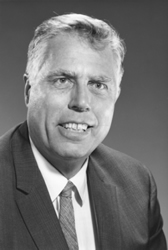

|

|
IN MEMORIAM
Richard Meier
Professor of Architecture, Emeritus
Professor of City and Regional Planning, Emeritus
Professor of Landscape Architecture and Environmental Planning, Emeritus
UC Berkeley
1920 – 2007
Richard Louis Meier, an emeritus professor and an early thinker on the importance of sustainability in planning, died on February 26, 2007, of pneumonia and congestive heart failure at Alta Bates Medical Center in Berkeley.
For more than 35 years, he was a faculty member in the Departments of Architecture, Landscape Architecture, and City and Regional Planning in the College of Environmental Design at the University of California, Berkeley. Meier taught at the University of Chicago (1950-1956) and the University of Michigan (1957-1967) before joining the Berkeley faculty in 1967 to help establish the new doctoral program in the Department of City and Regional Planning (DCRP).
He came to Berkeley “determined to apply systems-analysis tools for taking on some of the more intractable urban problems,” says department chair Robert Cervero. Calling Meier “a true renaissance man” who viewed cities through “a truly trans-disciplinary lens,” Cervero says that Meier was among the first urban scholars “to articulate the need for sustainable planning, to warn us of the threats posed by carbon emissions, and to seek out ways to improve the lives of the poor in developing countries.”
Meier earned his Ph.D. in organic chemistry at the University of California, Los Angeles (UCLA) in 1944. While working as a research chemist at Standard Oil in Richmond, California, he began talking with Berkeley scientists about the postwar implications of atomic energy and weapons and became a member of the Federation of Atomic Scientists. As the federation's executive secretary from 1947 to 1949, Meier helped explain to the public why American atomic research should be kept out of military control and why international nuclear proliferation should be contained.
He took part in a 1947 Princeton, New Jersey, conference of scientists, social scientists, and diplomats, chaired by Albert Einstein, that sought support for the Marshall Plan and other responses to the development of weapons of mass destruction. The meeting turned into an impassioned appeal to Edward Teller, the Hungarian-American theoretical physicist known as “the father of the hydrogen bomb,” not to work on that weapon, according to Meier's family.
During a Fulbright Fellowship in Manchester, England, in 1949-50, Meier shifted his attention to technological solutions for the problems of the world's biggest and poorest cities. As early as 1951, he convinced a University of Chicago colleague, the New Deal “brain-truster” Rexford Tugwell, of the inevitability of his (Meier's) forecasts. These included a long list of developments, among them the radical improvement of communications using ultra fax and television devices, more effective antibiotics, and “advances toward technological oneness in the world ... followed by tighter organization and by holistic planning devices,” Tugwell said.
Meier's first book, Science and Economic Development: New Patterns of Living (1956), predicted many technological advances that have come to pass. A review by U.K. economist Alec Cairncross in 1958 described Meier as “a super-planner who has been working on a blueprint for the world of 2000 A.D. and is ready to give marching orders not only to those who control new investment, but also to scientists in their laboratories and pilot plants.”
Born in 1920 in Kendallville, Indiana, Meier grew up the oldest of five children in a family of modest means. His father was a German-American Lutheran schoolteacher, choirmaster, and organist. His mother became seriously ill shortly after the birth of her youngest child, and much of the running of the household fell to young Meier.
At UCLA, Meier was denied a $50 student loan because his family had no property for collateral. Half a century later, following the death of his wife, Gitta Unger Meier, he used her life insurance to set up a foundation in India, along the lines of the Grameen Bank, to make revolving loans to help poor women establish small-scale businesses.
His research led him to believe that increasing education for girls and micro-entrepreneurial opportunities for women would be the most effective way to limit family size and to foster sustainable development more generally, observed Robin Standish, Meier's wife and collaborator in recent years.
Meier regarded his third book, A Communications Theory of Urban Growth (1962), as his most important and original contribution. Professor Jennifer Light of Northwestern University says that although the book was largely ignored on its publication, it is now essential reading for graduate students in communications.
In retirement, Meier continued teaching, writing, and generating new ideas, despite increasing disabilities. His final book, Ecological Planning, Management and Design, published online in 2003 (www-dcrp.ced.berkeley.edu/faculty/meier), laid out many of his strategies for creating sustainable communities, particularly for the urban poor in developing countries. It reflected his unquenchable optimism about the future and his belief that good planning and social justice are inseparable.
He is survived by his wife, Robin Standish of Berkeley; son, Alan of Berkeley; daughters, Andrea Meier of Chapel Hill, North Carolina, and Karen Reeds of Princeton, New Jersey; three stepchildren, David Standish of Oakland, Michael Standish of Los Angeles, and Miriam Standish Hartmann of Sunnyvale, California; four grandchildren and four step-grandchildren; and his brother, Ralph Meier of Crystal River, Florida. His first wife, Gitta, died in 1982.
Kathleen Maclay
Office of Public Affairs